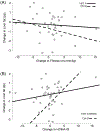Effects of short-term supervised exercise training on liver fat in adolescents with obesity: a randomized controlled trial
- PMID: 37731271
- PMCID: PMC11519784
- DOI: 10.1002/oby.23887
Effects of short-term supervised exercise training on liver fat in adolescents with obesity: a randomized controlled trial
Abstract
Objective: The objective of this study was to quantify the effects of a 4-week, supervised, high-intensity interval training (HIIT) on intrahepatic triglyceride content (IHTG, percentage), cardiorespiratory fitness (CRF), and cardiometabolic markers in adolescents with obesity.
Methods: A total of 40 adolescents (age 13-18 y, BMI 36.7 ± 5.8 kg/m2 ) at risk for metabolic dysfunction-associated steatotic liver disease (MASLD) based on obesity and elevated Fibroscan measured controlled attenuation parameter (CAP) scores were randomized to HIIT three times a week for 4 weeks (n = 34) or observation (control; n = 6). Liver magnetic resonance imaging proton-density fat-fraction (MRI-PDFF), CAP, oral glucose tolerance test, serum alanine aminotransferase, dual-energy x-ray absorptiometry, and CRF tests were performed before and after intervention. Within- and between-group differences were compared.
Results: A total of 13 (38%) and 4 (66%) children had MASLD by MRI-PDFF (IHTG ≥ 5%) in the HIIT and control groups, respectively. The implemented HIIT protocol had no impact on CRF or IHTG (baseline 5.26%, Δ = -0.31 percentage points, 95% CI: -0.77 to 0.15; p = 0.179), but it decreased the 2-h glucose concentration (baseline 116 mg/dL, Δ = -11 mg/dL; 95% CI: -17.6 to -5.5; p < 0.001). When limiting the analysis to participants with MASLD (n = 17), HIIT decreased IHTG (baseline 8.81%, Δ = -1.05 percentage points, 95% CI: -2.08 to -0.01; p = 0.048). Between-group comparisons were not different.
Conclusions: The implemented exercise protocol did not reduce IHTG, but it led to modest improvement in markers of cardiometabolic health.
© 2023 The Obesity Society.
Conflict of interest statement
CONFLICT OF INTEREST STATEMENT
The authors declared no conflict of interest.
Figures



References
-
- Vos MB, Abrams SH, Barlow SE, et al. NASPGHAN clinical practice guideline for the diagnosis and treatment of nonalcoholic fatty liver disease in children: recommendations from the Expert Committee on NAFLD (ECON) and the North American Society of Pediatric Gastroenterology, Hepatology and Nutrition (NASPGHAN). J Pediatr Gastroenterol Nutr. 2017;64(2):319–334. - PMC - PubMed
Publication types
MeSH terms
Grants and funding
LinkOut - more resources
Full Text Sources
Medical
Miscellaneous

